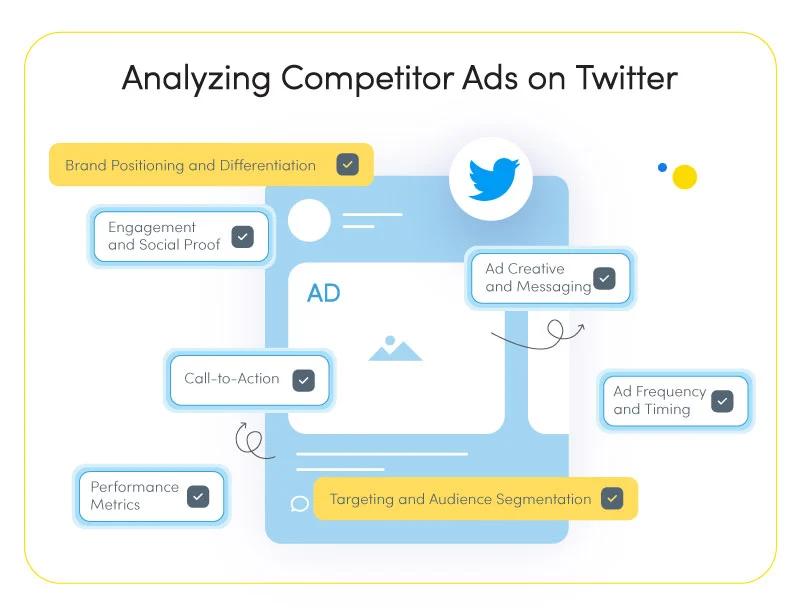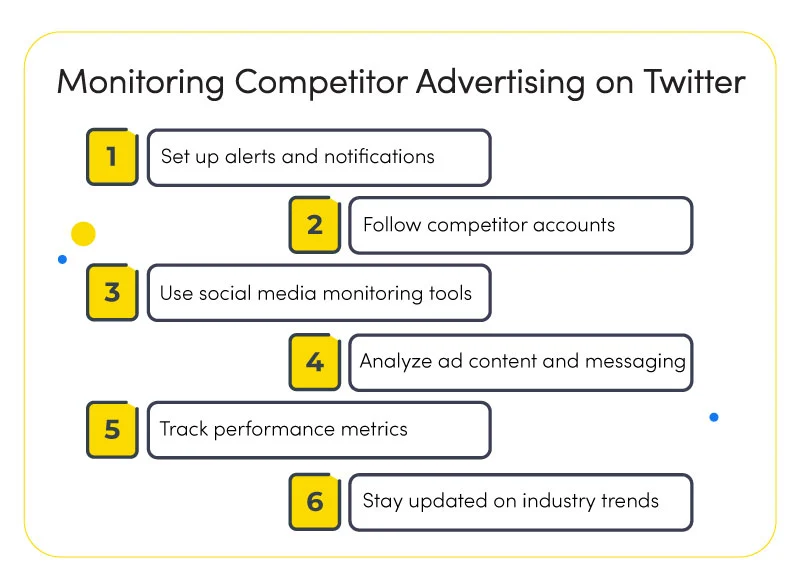Spying on competitors’ Twitter ads is crucial to developing a successful marketing strategy. By gaining insights into what your competitors are doing on Twitter, you can uncover valuable information about their messaging, targeting, and overall advertising approach. This knowledge allows you to identify opportunities, refine your campaigns, and stay ahead in the competitive landscape. This guide will explore various strategies and techniques to help you effectively analyze and understand your competitors’ Twitter ads. By doing so, you will be equipped with the knowledge to enhance your own advertising efforts and maximize your Twitter marketing results.

The following sections will delve into the methods and tools available to discover and monitor competitor ads on Twitter. We will provide step-by-step guidance on how to access and study competitor campaigns, along with tips for extracting meaningful insights from their ad content, engagement metrics, and targeting strategies. By the end of this guide, you will have a solid understanding of how to leverage competitor analysis to your advantage and refine your Twitter advertising approach. So, let’s dive in and uncover the secrets behind successful competitor ad analysis on Twitter!
Understanding Competitors’ Twitter Ads
In today’s competitive digital landscape, it is crucial for businesses to stay ahead of the game and maximize their advertising efforts. One effective way to gain an edge is by analyzing competitors’ Twitter ads. By understanding what strategies and messaging they employ, you can gain valuable insights into their approach and apply those learnings to enhance your own Twitter advertising campaigns.

There are several key reasons why analyzing competitors’ Twitter ads is valuable for your business:
| Benefits | Description |
|---|---|
| Identify trends and best practices | By studying competitor ads, you can identify trends and best practices within your industry. This includes analyzing the types of content, visuals, and language that resonate with your target audience. |
| Stay updated on market positioning | Competitor ads can provide insights into how your competitors position themselves in the market. By studying their messaging, brand voice, and unique selling propositions, you can gain a better understanding of how they differentiate themselves from others. |
| Uncover new advertising strategies | Competitors’ Twitter ads can introduce you to new and innovative advertising strategies. By examining their use of ad formats, targeting options, and ad extensions, you can discover new tactics that you can experiment with in your own campaigns. |
| Enhance your own campaigns | By analyzing competitors’ Twitter ads, you can gain inspiration and ideas to enhance your own campaigns. You can learn from their successes and failures, understand their approach to ad copywriting, design, and call-to-action, and adapt those strategies to suit your brand and objectives. This continuous improvement based on competitor analysis can help you stay relevant and competitive in the ever-changing advertising landscape. |
Remember, the goal of analyzing competitors’ Twitter ads is not to copy or imitate their strategies outright. Instead, it is about gaining insights and inspiration to inform your own unique approach. By understanding what works for your competitors and aligning it with your brand’s identity and goals, you can develop more effective Twitter ad campaigns and increase your chances of success.
Methods to Find Competitor Ads on Twitter
To gain insights into your competitors’ Twitter advertising strategies, you need to know how to locate their ads effectively. Here are some methods and techniques you can use to find competitor ads on Twitter:
- Manual exploration: Start by manually exploring your competitors’ Twitter profiles. Visit their Twitter accounts and scroll through their tweets and promoted content. Look for posts that are clearly promotional or contain ad indicators such as the “Promoted” label. This method allows you to see the types of content and messaging they are promoting directly on their profile.
- Twitter Ads Transparency Center: Twitter offers an Ads Transparency Center that allows users to view ads that are currently running on the platform. This tool provides transparency by displaying ads from different advertisers, including your competitors. Visit the Ads Transparency Center and search for specific competitors or browse through different categories to discover relevant ads.

- Follower analysis: Pay attention to the Twitter accounts your competitors follow. They may follow accounts related to advertising agencies or brands that specialize in advertising. By exploring these accounts, you may come across promoted tweets and ads from your competitors or similar businesses. This method can help you uncover competitor ads that may not be visible on their own profile.
- Social media monitoring tools: Utilize social media monitoring tools that offer ad intelligence features. These tools can help you track and analyze competitor ads across various social media platforms, including Twitter. They provide insights into the ad creative, targeting options, and performance metrics. Examples of such tools include Sprout Social, Brandwatch, and Hootsuite.
- Competitive analysis tools: Consider using competitive analysis tools specifically designed for monitoring competitor ads on social media platforms. These tools allow you to track competitor campaigns, ad spend, engagement metrics, and more. They provide in-depth insights into your competitors’ Twitter ad strategies and performance. You can use Twitter Ads spy tool for that.
By employing these methods and tools, you can effectively identify and access competitor ads on Twitter. This allows you to gain a comprehensive understanding of their Twitter advertising strategies, messaging, and creative approaches. Analyzing competitor ads can help you benchmark your own campaigns, uncover new opportunities, and refine your Twitter advertising strategy for better results.
Analyzing Competitor Ads on Twitter
Once you have located your competitors’ Twitter ads, it’s important to analyze them strategically to extract valuable insights. Here are some strategies and factors to consider when analyzing competitor ads on Twitter:
- Ad Creative and Messaging: Pay close attention to the ad creative and messaging used by your competitors. Analyze the visuals, headlines, and copywriting techniques they employ. Look for patterns or trends in their messaging style, tone, and brand voice. Identify what makes their ads compelling and engaging to their target audience.
- Targeting and Audience Segmentation: Examine the targeting options your competitors are using for their Twitter ads. Assess the specific audience segments they are targeting based on demographics, interests, and behaviors. Consider how they tailor their messaging to resonate with these different audience groups. Look for opportunities to refine your own targeting strategies based on their successful approaches.
- Call-to-Action and Conversion Strategies: Evaluate the call-to-action (CTA) used in competitor ads. Take note of the language, urgency, and clarity of their CTAs. Consider the landing pages or conversion paths they direct users to after clicking on the ad. Analyze the user journey and the steps they take to encourage conversions. Look for ideas to optimize your own CTAs and conversion strategies.

- Engagement and Social Proof: Look at the engagement metrics of competitor ads, such as likes, retweets, and comments. Assess the level of social proof they have generated through user interactions. Identify the types of content that receive high engagement and determine what resonates with the audience. Consider incorporating similar elements or strategies to enhance your own ad engagement.
- Performance Metrics: Monitor and analyze the performance metrics of competitor ads. Look at metrics such as impressions, clicks, conversions, and engagement rates. Evaluate how well their ads are performing and compare them to your own campaigns. Identify areas where your competitors are excelling and areas where you have an opportunity to outperform them.
- Ad Frequency and Timing: Observe the frequency at which your competitors are running their Twitter ads. Analyze whether they have a consistent presence or if they focus on specific time periods or events. Consider how their ad timing aligns with their campaign objectives and target audience behavior. Use this information to optimize your own ad scheduling and frequency.
- Brand Positioning and Differentiation: Assess how your competitors position their brand and differentiate themselves in their Twitter ads. Look for unique selling propositions (USPs) or value propositions they highlight. Identify their brand messaging and how it aligns with their overall marketing strategy. Consider how you can position your brand differently to stand out from the competition.
By analyzing competitor ads on Twitter using these strategies and considering the key metrics and factors mentioned above, you can gain valuable insights into their advertising tactics and performance. This analysis will help you refine your own Twitter ad campaigns, improve targeting and messaging, and stay competitive in the platform’s dynamic advertising landscape.
Monitoring Competitor Advertising on Twitter
To stay ahead of your competition and maintain a strong presence on Twitter, it’s crucial to continually monitor their advertising efforts. By closely tracking your competitors’ ads and campaigns, you can gain valuable insights and make informed decisions to improve your own marketing strategies. Here are some recommendations for effectively monitoring competitor advertising on Twitter:
- Set up alerts and notifications: Utilize tools and features that allow you to receive alerts and notifications whenever your competitors publish new ads or make significant changes to their campaigns. This helps you stay informed in real-time and enables you to respond promptly.
- Follow competitor accounts: Follow your competitors on Twitter and turn on notifications for their tweets. By doing so, you can closely observe their organic content and keep an eye on any promotional tweets or sponsored ads they share.
- Use social media monitoring tools: Take advantage of social media monitoring tools that specialize in tracking competitor activity. These tools provide comprehensive insights into your competitors’ Twitter ads, engagement metrics, follower growth, and overall social media performance.

- Analyze ad content and messaging: Regularly review and analyze the content and messaging of your competitors’ ads. Look for patterns, themes, and tactics they employ to attract their target audience. This analysis can help you identify gaps in your own strategies and inspire new ideas.
- Track performance metrics: Monitor the performance metrics of your competitors’ Twitter ads, such as engagement rates, click-through rates, and follower growth. Compare these metrics to your own performance to benchmark your success and identify areas for improvement.
- Stay updated on industry trends: Keep a finger on the pulse of your industry and stay updated on the latest trends in Twitter advertising. This includes staying informed about new ad formats, targeting options, and emerging strategies that your competitors might be experimenting with.
Remember, monitoring competitor advertising on Twitter should be an ongoing process. By consistently tracking their activity and making adjustments to your own campaigns based on the insights you gather, you can maintain a competitive edge and achieve better results on this influential social media platform.
Tips for Finding Competitor Ads on Twitter
Finding and analyzing competitor ads on Twitter can provide valuable insights for your own marketing strategies. To make your competitor ad discovery process more efficient and effective, here are some practical tips and best practices to consider:
- Follow industry-relevant hashtags: Identify and follow industry-specific hashtags on Twitter. This allows you to stay updated on the latest conversations and trends within your niche. By monitoring these hashtags, you may come across tweets and ads from your competitors that are targeting the same audience.
- Create private Twitter lists: Organize your competitors into private Twitter lists to streamline your monitoring process. This allows you to easily access and review their tweets and ads in one place without cluttering your main feed.
- Use advanced search options: Twitter’s advanced search feature enables you to refine your search criteria and narrow down results based on specific keywords, hashtags, usernames, and dates. Experiment with different combinations to discover relevant tweets and ads from your competitors.

- Leverage competitor analysis tools: Explore third-party competitor analysis tools that specialize in tracking and analyzing competitor ads on Twitter. These tools provide in-depth insights into competitor activity, ad performance metrics, and audience engagement, helping you gain a deeper understanding of their strategies.
- Engage with competitor tweets: Engaging with your competitors’ tweets can be a subtle way to gain insights into their strategies and monitor their audience’s responses. By observing the conversations and interactions surrounding their tweets, you can gather valuable insights about their target audience and the effectiveness of their messaging.
- Analyze follower interactions: Pay attention to how your competitors’ followers interact with their tweets and ads. Look for patterns, sentiments, and engagement levels to understand what resonates with their audience. This information can guide you in refining your own content and engagement strategies.
- Attend industry events and conferences: Industry events and conferences often generate a significant buzz on Twitter. By actively participating in these events and monitoring related hashtags, you can discover ads from your competitors that are specifically targeted at event attendees or industry enthusiasts.
Remember, the goal is not to copy your competitors’ ads but to gain insights, inspiration, and a competitive edge. By utilizing these tips and consistently analyzing competitor ads on Twitter, you can refine your own advertising strategies, better understand your target audience, and stay ahead in the ever-evolving social media landscape.
Conclusion
In today’s competitive digital landscape, finding and spying on competitor ads Twitter is essential for enhancing your own advertising campaigns. By implementing the strategies and techniques discussed in this guide, you can gain valuable insights, stay updated on market trends, uncover new advertising strategies, and enhance your overall marketing performance on Twitter.
Throughout this guide, we have highlighted the importance of analyzing competitor ads, from identifying trends and best practices to staying updated on market positioning. We have also provided methods for finding and analyzing competitor ads, as well as tips for efficient and effective competitor ad discovery.
By monitoring competitor advertising on Twitter and leveraging the available tools and resources, you can gain a deeper understanding of your competitors’ strategies, ad formats, targeting options, and messaging. This knowledge enables you to refine your own campaigns, experiment with new tactics, and continually improve your advertising approach.
Remember, the goal is not to simply replicate your competitors’ ads, but rather to gain inspiration, learn from their successes and failures, and adapt strategies that align with your brand and objectives. By consistently monitoring and analyzing competitor ads, you can stay relevant, competitive, and responsive to the ever-changing social media landscape.
We encourage you to take action and implement the strategies and techniques discussed in this guide. Stay proactive in tracking and analyzing competitor ads on Twitter, adapt your campaigns based on the insights gained, and continually optimize your Twitter advertising efforts to achieve better results.
By staying informed, innovative, and responsive to the advertising strategies employed by your competitors, you can position your brand for success on Twitter and effectively engage with your target audience. Embrace the power of competitor ad analysis on Twitter, and watch your own advertising campaigns thrive.
FAQs
How can I see my competitors’ ads on Twitter?
To see your competitors’ ads on Twitter, you can follow their Twitter accounts or search for their profiles and browse through their tweets and promoted content.
What tools can I use to find competitor ads on Twitter?
There are several tools available to help you find competitor ads on Twitter. One such tool is AdFlex, a powerful Twitter ads spy tool that allows you to track and monitor your competitors’ advertising activities. With AdFlex, you can easily discover their promoted tweets, analyze their ad copy and creatives, and gain valuable insights into their targeting strategies. By leveraging tools like AdFlex, you can stay one step ahead of your competitors and make informed decisions to improve your own Twitter advertising strategy.
Are there any legal or ethical considerations when spying on competitor ads?
When spying on competitor ads, it’s important to consider legal and ethical boundaries. Avoid directly copying their content or violating intellectual property rights. Focus on gaining insights and inspiration rather than imitating their ads outright.
How often should I monitor my competitors’ Twitter ads?
The frequency of monitoring competitor ads on Twitter depends on your industry and competitive landscape. It’s recommended to monitor them regularly to stay updated on their latest campaigns, but the exact frequency can vary. Consider setting up alerts or dedicating specific time intervals to monitor their activity.




 Facebook Ads Spy Tool
Facebook Ads Spy Tool TikTok Ads Spy Tool
TikTok Ads Spy Tool